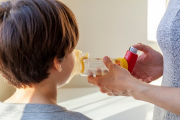Managing Asthma in School
 Schools play an important role in asthma management for children and adolescents. The goal of asthma management in school is for the student to be included in all educational activities, live as normal life as possible, and respond to asthma symptoms early to prevent complications from asthma. School nurses advocate for asthma-friendly policies and activities in the school environment and help to coordinate care for these students.
Schools play an important role in asthma management for children and adolescents. The goal of asthma management in school is for the student to be included in all educational activities, live as normal life as possible, and respond to asthma symptoms early to prevent complications from asthma. School nurses advocate for asthma-friendly policies and activities in the school environment and help to coordinate care for these students.
What is Asthma?
The Minnesota Department of Health (MDH) Asthma Basics webpage provides the following information:
- Pathophysiology of asthma
- Asthma symptoms
- Asthma triggers
- Resources to learn more.
Care Coordination for Students with Asthma
The MDH Asthma Management in Schools webpages provide the following information:
- Data
- Communication & care coordination with parents/guardians, healthcare providers, students, and other school staff
- Environmental triggers & mitigating asthma triggers in school
- Resources for developing policies and procedures, communication, and educational resources.
Statutory Requirements
There are legal requirements, statutes or laws that regulate how schools care for children with asthma and children with special needs.
Minnesota Statute 121A.22 states that students can self-administer their asthma medication via inhaler, if the parent/guardian provides written authorization, does not ask the school to administer the medication, and the inhaler is properly labeled for the student.
Minnesota Statute 121A.221 states that in order for an student to possess and use an asthma inhaler independently, a school nurse or other appropriate party must assess the student’s knowledge and skills to use the inhaler. If a school nurse is not available, the parent/guardian can submit written verification from the prescribing healthcare professional that documents an assessment of the student’s knowledge and skills has been completed and the healthcare professional believes the student can safely possess and appropriately use the inhaler.
The nurse should work with health care provider and parent/guardian to determine readiness, self-care skills and safety. Medication Procedures provides additional guidance related to self-carry and self-administration of emergency medications.
What is an Asthma Action Plan?
The Asthma Action Plan (AAP) is a personalized, written tool from the licensed prescriber that helps students, nurses, school staff and parents to manage the student’s asthma. AAP’s come in several formats. The most common includes the green-yellow-red zone format, may be symptom or peak flow driven and provides direction for when and which medication should be used daily, before exercise, or for when breathing becomes difficult. MDH Managing Asthma in Minnesota Schools provides additional information and detail not provided here. MDH Patient-Centered Asthma Care provides sample asthma action plan templates including languages other than English.
Nurse Care Planning in Schools provides additional information about emergency care plans/emergency action plans.
Nebulization
CDC states some procedures performed on patients are more likely to generate higher concentrations of infectious respiratory aerosols than coughing, sneezing, talking, or breathing. These aerosol generating procedures (AGPs) potentially put healthcare personnel and others at an increased risk for pathogen exposure and infection. In the school setting, open suction of airways is an Aerosol Generating Procedure (AGP) but there is limited data regarding nebulization as an AGP.
The COPD Foundation Nebulizer Consortium’s statement provides recommendations for preventing the spread of respiratory illness in health care settings and home environments. Schools should review these guidelines, evaluate the guidelines based on the school environment and implement accordingly. Read more here: New Guidance on Mitigating Infection Risk During Nebulization | Respiratory Therapy (respiratory-therapy.com)
If providing nebulization treatments in the school health office consider the student’s underlying health condition, such as a student with asthma who is experiencing asthma symptoms due to viral infection as compared to a student who may need pre-treatment for exercise induced asthma symptoms. Holding chambers/spacers are very effective in delivering asthma medications and are preferred in schools. Learn more MDH: Managing Your Asthma.
Infection Prevention and Control in the School Setting provides additional information including the use of personal protective equipment.
Resources
Asthma Resources for School Nurses: Emergency Care Plans, Training Tools & Resources document is not an exhaustive list; however, represents reputable resources for a School Nurse to utilize in his/her/their practice. These resources may be used in care planning for students, to strengthen competency for a nurse, or may be used to train other people performing these cares.
Minnesota Department of Health: Asthma provides additional resources including asthma training for youth coaches.
MDH Asthma Medications includes:
- Link to SMART TX webinar for school nurses
- Inhaler device technique, instructional videos, etc.
- Respiratory medication posters (downloadable for free)
- Multi language asthma patient education resources
MDH Home-Based Services includes a list of available home-based services programs with eligibility and resource information.
US Department of Education Office of Civil Rights Section 504 Protections for Students with Asthma